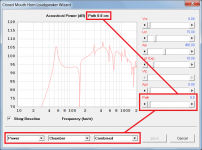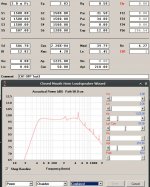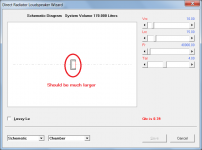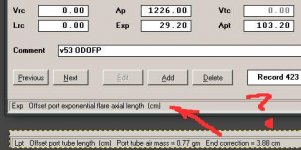Thanx for the update, david
The whole paraflex community just went crazy after the announcement - Champagner and holiday feeling all over
Me too! I can't wait to see how horrible the spectral decay is!
Auto/manual path appears in OD, but not in CH1 w/ OFP.
That's because with an OHOFP system the path length is not calculated automatically. The default value is zero and it is up to the user to specify the setting for their particular design. The Path slider is still available in the Wizard though.
Attachments
Me too! I can't wait to see how horrible the spectral decay is!
IMHO Spectral Decay is irrelevant for subwoofer applications especially on PA subwoofers. Most anomalies are outside the operations range > 100hz.
Somehow I have the feeling everything Paraflex needs to be 'judged' to the last grain of wood. I never seen these questions for gd, phase, waterfals, decays etc for any of the TH build here yo can go through the 6000 pages of th's and point me to any of the above graphs.
Anyhow...
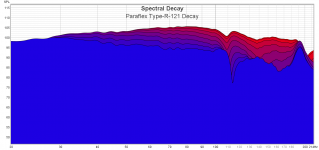
In comparison the Xoc1 Th same day same conditions same location
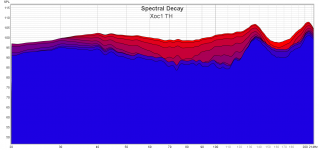
Of course these are not taken in an anechoic chamber. If you have one you can build a paraflex and take some measurements in your chamber.
Last edited:
That's because with an OHOFP system the path length is not calculated automatically. The default value is zero and it is up to the user to specify the setting for their particular design. The Path slider is still available in the Wizard though.
Thanks, David. Interesting. I don't get that slider, but if it's there, then that's my interoperability problem and I can work around it (anyone else on Wine 5.0 have this?).
Sincere thanks for this functionality, David. I have learned more about this tiny corner of the small domain in a short time than I can say. It's just absolutely worth screaming from the mountaintops how powerful and flexible you have made this software. I spend fifteen-fold the effort to just make sure my ducts and waveguides are ordered right (or even used right) in akabak than I spent actually _doing_ something in hornresp. And honestly, I'm still never sure what I model in akabak is modeling the problem I want to be modeling...I have years of sawdust into trusting hornresponse from before I asked so many silly questions
Attachments
I don't get that slider
Hi grindstone,
There is definitely something weird going on here
I get the same outcome as you for the record you attached - the path slider is disabled. My example was for a similar OHOFP system to yours, but for some reason the path slider was enabled in my case. I need to investigate - hopefully it should not be too difficult to track down and fix the problem.
Thanks for the feedback!
Kind regards,
David
I need to investigate
It didn't take me long to find the problem
I suspect that you must have started with an ODOFP record, which automatically calculates the path length by default, and then changed it to an OHOFP record. The Hornresp AutoPath flag was not reset to False when the change was made, which is why the Path slider was disabled in your case. I created my example as a new OHOFP record, so that the AutoPath flag was correctly set to False at the beginning, meaning that the Path slider was enabled in my case. Mystery solved!
The bug will be fixed in the next update.
before I asked so many silly questions
As far as I am concerned when it comes to Hornresp there are no silly questions - only silly answers sometimes...
...I never seen these questions for gd, phase, waterfals, decays etc for any of the TH build here yo can go through the 6000 pages of th's and point me to any of the above ...Of course these are not taken in an anechoic chamber. If you have one you can build a paraflex and take some measurements in your chamber.
Dont need one, thats whst hornresp is for...Ive never seen anyone question gd phase, waterfalls, decays eyc either (for a paraflex) either. Its called neglect...I'm just messing with you! I know that anybody building a paraflex isn't too concerned about technical sound quality....The focus is just the boom boom boom
Last edited:
It didn't take me long to find the problem.
I suspect that you must have started with an ODOFP record, which automatically calculates the path length by default, and then changed it to an OHOFP record.
Wasn't OHOFP a pharoah or something? Confirming that indeed you have nailed my usage. It's one of the pure joys to be able to just turn almost anything into almost any other kind of model and HR hangs with it better than it should. The power of that, in aiding understanding, can't really be measured, IMO. THANK YOU!!!!
Think I have fallen way behind here, so much new stuff happening.
You and me both!
Really I am not so interested in a resonant system for myself. But I see the utility of it for many people.
Time to learn some new tricks I think!
Indeed it is Mark.Time to learn some new tricks I think!
I am more interested in the offset port myself, so will look into that in the near future.
Will have to reacquaint myself with the software all over again to understand what all the functions can do.
Wasn't OHOFP a pharoah or something?
There were four egyptian pharaohs named Amenhotep, which is close enough
There were four egyptian pharaohs named Amenhotep, which is close enough.
Ah, "public school".
Is the end corr in these OFP using the R of Apt or Ap? If the hover info code is already in there for free, it would be welcome. Thank you again, David. Further empowered and having big-fun, here!
Attachments
Hi Guys,
I am new to TL but with adequate knowledge on other enclosure designs, maybe I will be asking few basic questions to get started, yes I have read few documentations.
1. What are the things I need to see in your HornResp SW while designing an offset TL design, I do understand other enclosure designs, so I am only asking specific to TL and and the SW.
2. What is Acoustic Power Graph I need to see while designing the TL, I see the combination graph, what actually is OUTPUT-1, OUTPUT-2, COMBINED and how to understand and use them effectively.
3. I see all other graphs like DISPLACEMENT, PHASE, IMPEDANCE, MOUTH VELOCITY etc. DELAY is another graph that is unique to the TL and HornResp, and I want to understand the graph output more and how to use them.
4. What is the density value of polyester fiber fill I need to input, my supplier gave me data 20Kg/m^3 for 50mm thick, 1000 GSM Polysynth Wool.
Thanks in advance, Mallick
I am new to TL but with adequate knowledge on other enclosure designs, maybe I will be asking few basic questions to get started, yes I have read few documentations.
1. What are the things I need to see in your HornResp SW while designing an offset TL design, I do understand other enclosure designs, so I am only asking specific to TL and and the SW.
2. What is Acoustic Power Graph I need to see while designing the TL, I see the combination graph, what actually is OUTPUT-1, OUTPUT-2, COMBINED and how to understand and use them effectively.
3. I see all other graphs like DISPLACEMENT, PHASE, IMPEDANCE, MOUTH VELOCITY etc. DELAY is another graph that is unique to the TL and HornResp, and I want to understand the graph output more and how to use them.
4. What is the density value of polyester fiber fill I need to input, my supplier gave me data 20Kg/m^3 for 50mm thick, 1000 GSM Polysynth Wool.
Thanks in advance, Mallick
Is the end corr in these OFP using the R of Apt or Ap?
Hornresp does not add a throat end correction to either a horn segment or to a flared port. If no EC details are shown when the mouse pointer is moved over the relevant input parameters, then this means that no internal end correction has been added.
If an end correction were to be included, it would apply to Apt (the throat end). No end correction is necessary at Ap (the mouth end) because the radiation impedance is used instead. The difficulty would be deciding what length to make the correction, as the formula used for a cylindrical port tube is not really applicable to a flared port tube.
In essence, the internal end correction is effectively confined to cylindrical port tubes where Hornresp thinks that they are being used as part of a traditional bass reflex type system.
2. What is Acoustic Power Graph I need to see while designing the TL, I see the combination graph, what actually is OUTPUT-1, OUTPUT-2, COMBINED and how to understand and use them effectively.
Others to note - the above question has been answered via email.
4. What is the density value of polyester fiber fill I need to input, my supplier gave me data 20Kg/m^3 for 50mm thick, 1000 GSM Polysynth Wool.
The density value of 20 kg/m^3 is essentially meaningless as far as the Hornresp simulation model is concerned. Your supplier needs to provide you with the airflow resistivity value of the material in mks rayls/m or equivalent units.
- Home
- Loudspeakers
- Subwoofers
- Hornresp
